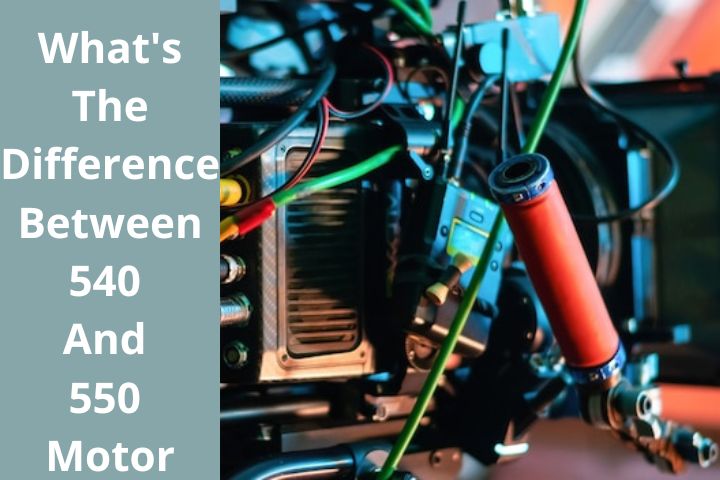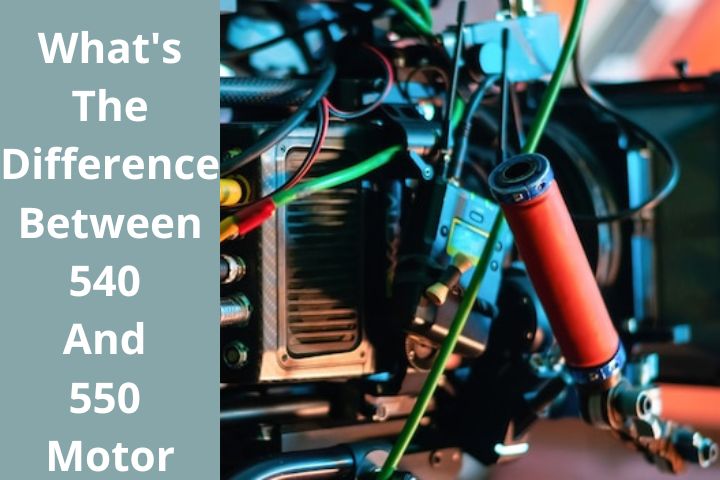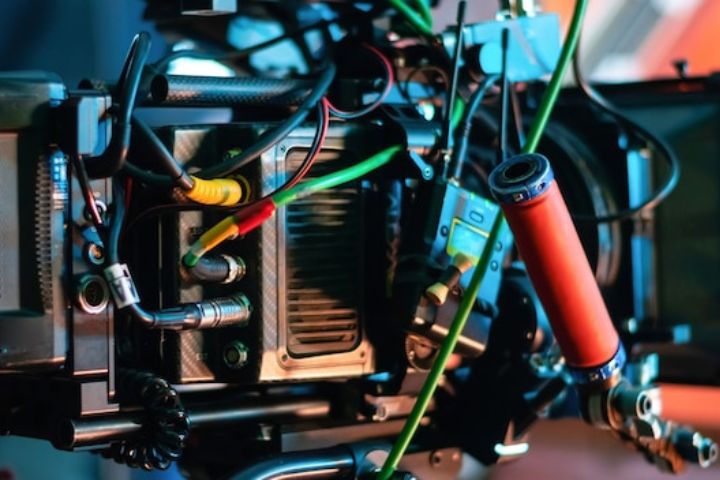
What’s The Difference Between 540 And 550 Motor? RC car motors are an integral component of the radio-controlled cars that we have come to know and love. Getting these electric motors to run efficiently requires a delicate balance between weight, power, speed, and efficiency. While it is true that bigger motors tend to offer more torque, integrating larger motors into your RC car could significantly increase the amount of energy consumed. Sophisticated hobbyists understand how to maximize performance without sacrificing efficiency – this often involves using different sizes and types of electric motors in tandem. Ultimately, with careful design and the right motor combination, you can make your RC car fly.
540 Motor
540 electric motors are popular for their performance and durability in a wide range of applications. Often used in radio-controlled cars, boats, and other hobbies, the 540 motors are also used in professional settings to drive industrial equipment like conveyors and pumps. With an output power that’s up to two times higher than standard motors and an innovative design that reduces vibration, the 540 motors is well suited for heavy-duty use. The motor is also relatively heat tolerant, allowing users to get maximum efficiency with minimal burring or eventual damage. Whether you’re using it to race your RC car around the track or powering a key component of your production process, the 540 motor is sure to deliver reliable performance every time.
550 Motor
The 550 motor is a versatile workhorse. It combines features like adjustable speed, easy assembly, and durable design that make it an ideal choice for a wide range of projects. Machine shops have used these products to build precision tools and devices, while weekend hobbyists may use them to power the automated creations of their imagination. With a simple hookup to a battery or power source, the 550 Motor comes alive and can accomplish almost anything you set your mind to. Whether you’re looking for full-power drilling equipment or just want to craft something special with your kids, the 550 Motor gives you the freedom to do it all.
Difference between 540 and 550 Motor
The Size Difference between the 540 and 550 Motors
What’s The Difference Between 540 And 550 Motor? The size difference between 540 and 550 RC motors is quite stark. The 540 motor is much smaller than the 550, with a significantly smaller diameter, length, and weight. This can give users an advantage when designing RC vehicles because the 540 motor allows for greater customization of the chassis while still providing ample power. It also gives racers a distinct edge since they tend to use smaller, more aerodynamic cars to increase speed and maneuverability. However, users should be aware that the 550 motor may boast more power, but it comes at a higher cost due to its larger size. Ultimately though, both types of motors have their distinct advantages depending on what type of RC vehicle is being built.
Battery Requirements for the 540 and 550 Motors
RC motors are an important part of the RC hobby, but they require special batteries to work properly. The 540 and 550 motors are no exception to this rule. These motors both operate best with 7-cell NiMH batteries that pack in roughly 8.4 volts and up to 8000 mAh of current. Although you can customize your battery packs for more tuning capabilities, these values provide the most efficient performance for your 540 or 550 motors. To ensure optimal performance, always use high-quality cells, and remember to take good care of your battery by storing it in a cool, dry place when not in use.
In most cases, 2s batteries are the optimum choice for the 540 motors. In most cases, 2s LiPo batteries will power your RC car if it has a 540 motor. To avoid the rapid overheating of a 540 motor, these batteries typically produce no more than 8.4 volts. However, the heavier internal components of 550 motors cannot be driven by 2s LiPo batteries since they lack the necessary amperage and voltage. Utilizing a 550 motor with 2s batteries will not result in any noticeable performance improvement. However, a 3s or 4s battery pack is a huge improvement in both power and speed when driving the 550 motors. Due to the motor’s high amp consumption, a battery with a C4 rating is recommended.
When it comes to selecting the right battery pack for 540 and 550 class RC Motors, it is important to select one that is capable of providing the necessary performance levels required by these specific motors. Battery requirements are dependent upon the type of motor used, and as such, it is essential to understand the voltage, current and maximum discharge rate before making a purchase. As with any power source, ensuring the battery density is sufficient in order to ensure optimal performance and longevity will be crucial in your RC motor selection process. By taking into account battery requirements when selecting 540 and 550 class motors, racers can be sure that their engines will have all of the power needed for top district times and race victories.
The Power Difference between the 540 and 550 Motors
One element of a successful RC (remote control) car build is the motor. Two popular sizes are the 540 and 550 RC motors. There is a huge difference in performance between these two types of motors; you get what you pay for when it comes to power output. The 540 motors, usually less expensive, are typically used for street racing or general use on flat terrain. Conversely, the more powerful 550 motors–about 20% more powerful than the 540–is designed for any kind of track or off-road course, with its increased torque, increased RPM, and enhanced efficiency. With all that additional power, the 550 motors can give your car an edge when it comes to speed and acceleration; additionally, because it runs cooler than a 540 motor at medium to high speeds, it helps reduce wear and tear on your car components as well as potentially prolonging battery life.
The Speed Difference between the 540 and 550 Motors
RC motors have come a long way over the years, giving owners the capability to customize and control their vehicles with more power, better speed, and greater responsiveness. When thinking about the differences between 540 and 550 RC motors, one of the most striking features is their speed. While both motors offer high levels of performance, there is a notable difference in top-speed capabilities between them. The 540 motor generally provides about 21K RPM whereas the 550 delivers up to 30K RPM. This remarkable difference gives drivers much more control over acceleration and quick maneuverability in their races. Furthermore, it’s worth noting that when considering these two popular options you will want to consider the cost as well since 550s are often pricier than 540s.
Usage Difference
Two-wheel-drive radio-controlled vehicles of 1/12 and 1/10 scales benefit greatly from the 540 motors. The most common electric motor size is the 540, which is ideal for most cars and trucks. 550 motors are not recommended for most 2WD systems due to their increased weight and excessive power. Even if you do, know that the more power the model has, the more skill you’ll need to handle it. Here are the best 540 motors we’ve found, in case you’re wondering.
Powerful and reliable 550-cc motors are ideal for backyard smashers. People who go over rivers or in wet weather can also benefit from this product. Their upkeep is a breeze. Just wipe them dry and apply some lubricant. And by the time the next bush party rolls around, they’ll be set.
Because of this, they are great for use in large-scale rock crawlers and model boats. They are also noticeably less jerky at milder throttle settings. When it comes to boats, this is helpful, but when it comes to crawlers, it’s crucial. These motors also feature an inbuilt fan to aid in cooling.
Kv and Number of Turns Difference
KV refers to the number of revolutions produced by a motor for every volt of power applied to it. The motor’s speed and output will improve in proportion to the square of the Kv value. In the same vein, the T-shaped housing of a motor is a common symbol. This is shorthand for several revolutions. The number of twists of wire within the motor represents the total quantity of wire wrapping. Turns more than one indicates more wire. Therefore, a slower motor is the result of increased resistance.
A 540 motor typically has 20–27 revolutions and operates between 4.8V and 12 V. A 550 motor requires 12 revolutions and 6V to 24V. Here, the 550 motor triumphs because it has fewer turns and is thus quicker than the other two.
Should You Use the 540 Or the 550 Motor
When it comes to RC cars, the decision of whether to utilize a 540 or 550 motor relies on the application at hand as well as the performance qualities that are sought. In general, the 540 motor delivers a greater amount of torque at a lower RPM, while the 550 motor delivers a lower amount of torque at a higher RPM.
It’s possible that a 550 motor might be a better choice for you if you’re searching for increased power and acceleration. On the other hand, if you want increased control and steadiness, a 540 motor is probably going to be the best option for you. In the end, the answer will be determined by the type of terrain you will be traveling on as well as your own personal tastes.
It is essential to keep in mind that the 540 or 550 motor is just one component of an RC car and that the performance of the car is also determined by other aspects, including the battery, the transmission, and the general design of the car.
540 Vs. 550 Which RC Motor Is Better
To a significant extent, whether an RC car should have a 540 or 550 motor depends on the user’s personal preference as well as the application in question. Both types of motors come with their own set of benefits as well as drawbacks; making the right decision depends on the performance aspects that are most important to you.
Because 540 motors often deliver more torque at a lower RPM, this configuration is superior in terms of its suitability for control and stability. Off-road vehicles and rock crawlers, which are employed in environments where the ability to crawl over obstacles while maintaining control is essential, frequently make use of these components.
On the other side, 550 motors have a higher rotational speed but a lower torque, which means they are better suited for power and acceleration. They are frequently utilized in racing automobiles as well as on-road vehicles since these applications place a premium on both speed and power.
It is also crucial to note that the 540 or 550 motor is just one component of an RC car, and that the performance of the car is determined in large part by other aspects, including as the battery, the transmission, and the general design of the car. Before making a choice, it is essential to take into account all of the aspects that can influence the performance of an RC car and select the motor that caters to your requirements the most effectively.
Read also: Can You Run Two 2.4 GHz Rc Cars at the Same Time
Conclusion
RC car motors are an essential component of any successful radio-controlled car. For many hobbyists, the motor is one of the most important decisions they will make regarding their vehicle. There are numerous types of motors available, ranging from brushless motors that offer increased speed and torque to brushed motors known for their reliability. Tuning and maintenance are key when it comes to getting the most out of an RC car motor; this ensures that your car runs at peak performance. Those interested in racing may spend more time fine-tuning their robots since every millisecond can mean a very different result on the track. RC car enthusiasts should select a motor that fits their needs and budget for an enjoyable experience with their mini machine.


